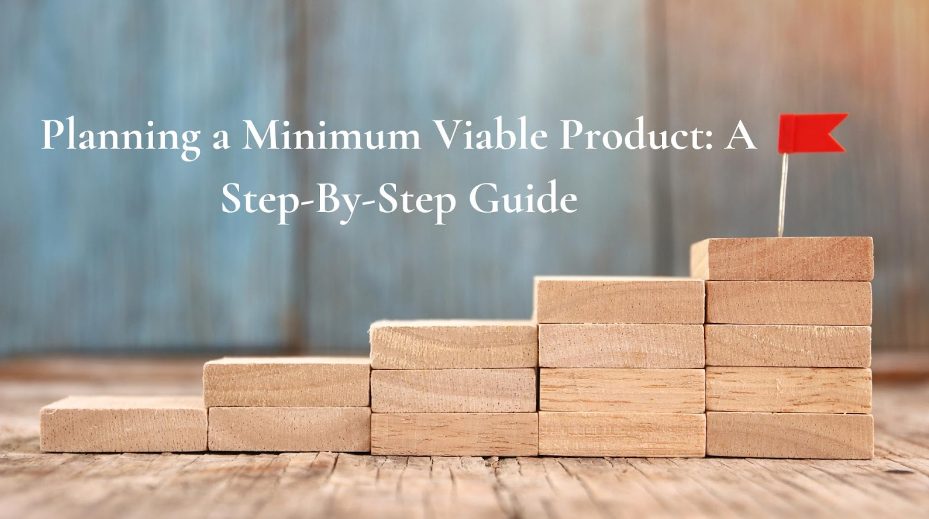Hey, future tech wizards and entrepreneurs! Today, we’re diving into the exciting world of planning a Minimum Viable Product, or MVP.
You might be wondering, “What’s an MVP, and why do I need one?” Well, don’t fret; we’re here to guide you through this vital step in turning your brilliant idea into reality. Whether you’re building a new app, a website, or any tech project, an MVP is your secret sauce for success.
What’s An MVP, Anyway?

First of all, let’s have an idea about the concept of MVP.
Imagine you are planning to launch a product in the market. But you are having doubts about its success and customer reception. So, you make a prototype of your product and release it in the market.
Your prototype has no fancy designs or promotional accessories. It is just a simple version of your actual product. But it has the core features that will get the job done for your customers.
Similarly, this prototype version of your product is the MVP. Launching an MVP in the market helps you to predict its performance and evaluate its market reception.
Why MVPs Matter

MVPs are game-changers for several reasons,
- Low Risk: You’re not pouring all your resources into a full product right away.
- Early Validation: You can test your idea quickly and see if it resonates with users.
- Cost-Effective: Developing an MVP is often more affordable than a complete product.
- Flexibility: It allows you to adapt based on user feedback and market changes
Mainly, the MVP will help you assess the success rate of your idea in the context of the market and consumer base. Based on the data of its performance, you can decide whether to move forward with the idea or discard it.
Step 1: Define Your Idea
Before you dive into creating your minimum viable product (MVP), you need a clear idea of what you’re building.
Ask yourself:
What problem does your product solve? Who’s your target audience? Why should people use it? This is the foundation of your MVP.
Step 2: Set Your Goals
Setting your goals before venturing into the making of the MVP is crucial. You need to have clear objectives and goals for your product. So, try to identify your objectives with the product in the market.
Ask yourself:
What do you want to achieve with your MVP? Are you aiming to test your concept, attract investors, or start gaining users?
Define your goals so you can measure your MVP’s success accurately.
Step 3: Feature Selection
Now, it’s time to decide what features make it into your MVP. Keep it simple! Focus on the core functionalities that address your users’ primary needs. Don’t get distracted by bells and whistles; you can add those later.
Step 4: Create A Prototype
Design your MVP. It’s like sketching the blueprint of a building before construction. You don’t need a full-fledged product yet; wireframes and mockups will do. This helps you visualize how your MVP will look and function.
Step 5: Develop Your MVP
Now, it’s time to bring your MVP to life. You can either hire a developer or use user-friendly no-code/low-code platforms. Remember, your MVP isn’t the final product; it’s a simplified version with essential features.
You don’t need to put expensive resources and materials into the making of your MVP. It should be cost-efficient to ensure that excess fund is stored for the future production of the actual product.
Think of it as the starting point, and you’ll build upon it based on user feedback and evolving needs, saving time and resources along the way.
Step 6: Test, Test, Test
After your MVP is ready, the next crucial step is testing. This involves putting your MVP in the hands of a small group of users or beta testers.
By collecting their feedback and closely observing how they interact with your product, you gain insights into what’s functioning well and what requires enhancement.
This process is about fine-tuning your MVP based on real user experiences, helping you make informed decisions for the next phases of development.
Step 7: Iterate
In the iterative journey of MVP development, user feedback becomes your compass. Taking their valuable input into account, you’ll make the necessary adjustments to enhance your MVP.
This process often involves multiple iterations, each one refining your product bit by bit. This approach allows your product to grow in response to real-world feedback, making it stronger and more user-friendly as you progress.
Step 8: Launch And Collect Data
Once you’ve fine-tuned your MVP and are confident in its performance, it’s time to introduce it to a wider audience.
As users start interacting with your MVP, focus on gathering data that provides insights into their behavior and preferences. It’s a pivotal phase for further refining and scaling your product based on real-world engagement and feedback.
Step 9: Analyze And Learn
Analyzing the data collected from user interactions is a critical step in evaluating your MVP’s performance.
It allows you to assess whether your MVP met the goals you initially set. By identifying areas of success and those in need of improvement, you gain valuable
insights that inform your next strategic moves. This information is not just important; it’s essential for making well-informed decisions and steering the direction of your project as it progresses.
Step 10: Decide On The Next Move
Now that you have real-world user data, decide what’s next. Do you continue refining the MVP, pivoting to a new direction, or scaling up to a full-fledged product? Your decision depends on your goals and what you’ve learned.
Common MVP Mistakes To Avoid
- Feature Overload: Trying to include too many features in your MVP can make it complex and costly. Keep it simple.
- Ignoring User Feedback: Don’t disregard user input. It’s a goldmine for improvement.
- Skipping the MVP Stage: Building the full product from the start is risky. An MVP helps you test the waters with less risk.
- Not Setting Clear Goals: Without goals, you won’t know if your MVP is successful.
- Perfectionism: Your MVP doesn’t need to be perfect; it needs to be functional.
Conclusion
Planning your Minimum Viable Product (MVP) is like laying the foundation for a skyscraper. It’s the essential first step in turning your idea into a real product.
Your MVP is the baby version of your big idea, designed to help you test, learn, and grow. Remember, you’re starting small, and your MVP is your secret weapon for success.
Key Takeaways
- Simplicity Is Key: Your MVP is the simplest form of your idea, like a basic sketch.
- Early Testing Matters: It’s important to see if people like your MVP and if it works well.
- Learn and Improve: Collect feedback and make your MVP even better with each step.
- Data Guides You: Pay close attention to what the data from users tells you; it’s like having a map.
- Stay Flexible: Be ready to change and adapt based on what you learn.
Read Also:




























